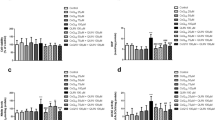Summary
This study examined whether picolinic acid (PIC) inhibits quinolinic acid (QUIN) — induced excitotoxicity through zinc chelation. Injection of QUIN into the nucleus basalis magnocellularis significantly depleted cortical choline acetyltransferase activity 7 days post injection and PIC inhibited this response. Zinc augmented the QUIN- but not NMDA-induced response. When PIC was co-administered with zinc, PIC failed to attenuate the QUIN-induced response. The inhibition of QUIN — induced cholinergic toxicity by PIC may involve chelation of zinc.
Similar content being viewed by others
References
Beninger RJ, Colton, AM, Ingles, JL, Jhamandas K, Boegman RJ (1994) Picolinic acid blocks the neurotoxic but not the neuroexcitant properties of quinolinic acid in the rat brain: evidence from turning behaviour and tyrosine hydroxylase immunohistochemistry. Neuroscience 61: 603–612
Cockhill J, Jhamandas, K, Boegman RJ, Beninger, RJ (1992) Action of picolinic acid and structurally-related pyridine carboxylic acids on quinolinic acid induced cortical cholinergic damage. Brain Res 599: 57–63
Fonnum F (1975) A rapid radiochemical method for the determination of choline acetyltransferase. J Neurochem 24: 407–409
Hollman M, Boulter J, Maron C, Beasley L, Sullivan J, Pecht G, Heinemann (1993) Zinc potentiates agonist-induced currents at certain splice variants of the NMDA receptor. Neuron 10: 943–954
Jhamandas K, Boegman RJ, Beninger RJ (1994) Quinolinic acid-induced brain neurotransmitter deficits: modulation by endogenous excitotoxin antagonists. Can J Physiol Pharmacol 72: 1473–1482
Lee PJ, Jhamandas KJ, Boegman RJ, Beninger RJ (1996) Zinc chelators inhibit excitotoxic action of quinolinic acid on basal forebrain cholinergic neurons. Soc Neuroscience Abstracts 22: 806
Lowry OH, Roseborough NJ, Farr AL, Randall RS (1951) Protein measurement with folin phenol reagent. J Biol Chem 193: 265–275
Pawley AC, Flesher S, Boegman RJ, Beninger RJ, Jhamandas KH (1996) Differential action of the NMDA antagonists on cholinergic neurotoxicity produced by N-methyl-d-aspartate and quinolinic acid. Br J Pharmacol 117: 1059–1064
Schwarcz R, Foster AC, French ED, Whetsell WO Jr, Kohler C (1984) Excitotoxic models for neurodegenerative disorders. Life Sci 35: 19–32
Smart TG, Xie X, Krishek BJ (1994) Modulation of the inhibitory and excitatory amino acid receptor ion channels by zinc. Prog Neurobiol 42: 393–439
Stone TW, Connick JH (1985) Quinolinic acid and other kynurenines in the central nervous system. Neuroscience 15: 597–615
Suzuki K, Yasuda M, Yamasaki K (1957) Stability constant of picolinic acid and quinoldic acid chelates of bivalent metals. J Phys Chem 61: 229–231
Author information
Authors and Affiliations
Rights and permissions
About this article
Cite this article
Jhamandas, K.H., Boegman, R.J., Beninger, R.J. et al. Role of zinc in blockade of excitotoxic action of quinolinic acid by picolinic acid. Amino Acids 14, 257–261 (1998). https://doi.org/10.1007/BF01345272
Received:
Accepted:
Issue Date:
DOI: https://doi.org/10.1007/BF01345272




